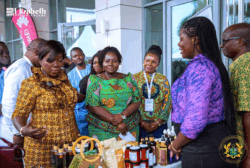The continuous reliance on mining and the services sectors over the past decade has not created enough job opportunities needed for the population at large to escape poverty, the latest World Bank Ghana Systematic Country Diagnostic (SCD) report has shown.
The SCD, which is aimed at identifying the most important challenges and opportunities a country faces in advancing toward the twin goals of ending extreme poverty and increasing shared prosperity in a sustainable manner, notes that: “Such a service-cum-mining economy, however, does not produce employment opportunities needed for the population at large to escape poverty”.
Data by the Institute of Statistical, Social and Economic Research (ISSER) in March, 2017 revealed that only 10 percent of graduates find jobs after their national service, and it can take up to 10 years for a large number of graduates to secure employment.
A greater number of high school students remain unemployed or underemployed, with many doing menial tasks to earn a daily living.
“This is at the heart of the observation that while most Ghanaians work either in formal or informal sectors, having a job does not mean escaping poverty. So, more quality labour-intensive growth is needed to bring the economy on track to continue its impressive poverty-reduction trend.
“This requires an interplay of micro-and-macro-economic activities and reforms, as only a well-managed macro-economy will bring about the conditions for a dynamic economy to unfold,” the report noted.
The SCD attributes the growing unemployment to the shift in focus from the agricultural sector—which used to employ a majority of the population—to service and the mining sector after the discovery and start of commercial oil production offshore Cape Three Points, Western Region.
“After decades of stagnation, growth and poverty reduction intensified in the 1990s – but growth elasticity of poverty has declined since. Ghana’s poverty reduction achievement is one of the great success stories on the African continent since the 1990s. And poverty reduction coincided with an intensifying rate of economic growth. But even though growth rates continued to increase between 1990 and 2012, the growth elasticity of poverty has declined.
“This is related to the structural transformation that has been happening over the last 30 years – i.e. from agriculture to low productivity services (often self-employment) and natural resources. While Ghana’s economy has had always a backbone in natural resources (cocoa, gold), the natural resources position in the economy has intensified with oil and gas since the 2010s,” the report noted.
Decline of the labour-intensive agric sector
In terms of growth, compared to other sectors, the agriculture sector’s performance has been disappointing for years now.
The quarterly GDP figures by the Ghana Statistical Service show that since 2010, with the exception of a few quarters, industry and services have outperformed agriculture in terms of growth.
In the second quarter of 2010, agriculture grew by 12.1 percent, whereas industry and services grew by 3.8 and 4.3 percent respectively. It never grew past the two sectors, even recording negative growth rates in the first three quarters of 2012, till it overturned its fortunes and recorded 9.8 percent in the fourth quarter.
Hopes were high then, as growth further increased in the first and second quarters of 2013 to record 24 and 50.8 percent respectively. But, sadly, it took a sharp nose-dive into the negatives as it recorded -12.6 and -0.6 in the last two quarters of that year.
The negative growth continued in 2014, until the third quarter when it grew by 28 percent; making it the first time it grew past industry and services since quarter four of 2012. Since then, however, it has never grown past the other two sectors, even though it has moved from the negatives.
In the second quarter of 2017, agriculture grew by 3.4 percent whereas industry and services grew by 19.3 and 5.6 percent.
Apart from the third quarter of 2009, when the agric sector became the largest contributor to GDP by recording 41.9 percent, compared to 17.6 and 40.5 percent recorded by industry and services, it has never hit that mark in decades.
In 2017, the agriculture sector contributed 22.6 percent, whereas industry and services contributed 24.2 and 53.2 percent respectively.
The sector, despite its potential, has continued to be viewed as a high risk sector by many financial institutions. This is reflected in the interest charged on loans advanced to the sector.
The Annual Percentage Rates (APR) and Average Interest (AI) report for January 2018 released by the Bank of Ghana (BoG) have shown that the lending rate to the agriculture sector remains high.
The average lending rate to the sector, according to the report, stands at 30.4 percent.
Interestingly, Bank of Baroda, Barclays and Access Bank offer a much lower rate than ADB, which was set-up to support the agric sector.
Bank of Baroda offers a rate of between 22-28 percent; Barclays, 22.8-32.4 percent; and Access Bank offers a rate of 27 percent.
To lift millions of the population out of poverty, the report encouraged investment in ‘labour-intensive’ sectors.










